

Introduction to Artbank
Artbank is a unique Government artist support and access initiative. For over 40 years we have supported thousands of Australian artists, building an impressive collection of over 10,000 artworks.
Artbank artworks enrich government, business and residential spaces, exposing a wide variety of people to contemporary Australian art.
The Artbank collection was founded with an endowment of 600 artworks from the National Collection (now the National Gallery of Australia) and has since grown to include more than 10,000 works spanning media including painting, sculpture, video and photography.
Through leasing works to individuals, companies and governments, Artbank lives up to its policy principle of promoting broad access to Australian contemporary art. Through our leasing of artworks to Australian embassies and overseas posts, we provide access to Australian contemporary art in approximately 70 countries across the globe.
Artbank has similarities with other collecting institutions in how we undertake aspects of the business, but we are very different in both why we collect artwork and how we promote Australian art to stakeholders, clients and the public.
For the broader community, we make Australian contemporary art accessible in ways other collecting institutions cannot.
With Artbank artworks in workplaces and other public and private places around Australia and the world, we enable the broader community to access some of the best examples of Australian contemporary art.
This allows for a different, more everyday type of engagement with artworks than a gallery or museum exhibition offers. By displaying works in offices, government buildings and homes, we present artworks to many who would never visit a public or private gallery, breaking down traditional barriers to this art form.
Browse our collection artbank.gov.au
@instagram.com/ artbankau facebook.com/ ArtbankArt
Subscribe to eNews: artbank.gov.au/ about-artbank
Artbank Sydney, photo Tom FergusonPaddy Carroll TJUNGURRAYI
Untitled (Ceremony of the Wettie), 1981
Painting

Synthetic polymer paint on canvas #940
An artist with Anmatyerre and Walipri tribal affiliations, Tjungarrayi was born at Yarrungkanyi, north-west of Yuendumu in the Northern Territory and spent his early years around his mother's country in Haasts Bluff. Tjungarrayi worked for many years as a carpenter and stockman at Narwietooma Station, droving cattle across the Tanami Desert and helping to lay telegraph lines through remote areas. Tjungarrayi began painting in about 1977 as a founding member of the Papunya Tula art movement.
This painting shows the details associated with the traditional ceremony of the "wettie" at Yaribilongu (on Newhaven station, north west of Alice Springs). "Wettie" are the long poles which are tied with leafy boughs to the legs of ceremonial dancers. Their full significance is not disclosed. The central motif is of sacred ancestral boards shown to the young men after their initiation is complete. The meaning of the motif is considered secret and was not explained.
Paddy Carroll Tjungurrayi was one of five Papunya Tula artists to be invited to submit designs for the mosaic for the new Parliament House in Canberra upon construction.

Sheila Napaljarri BROWN
Yanjillpirri Jukurrpa (Milky Way Dreaming), 2002

Painting Synthetic polymer paint on canvas #11037
Sheila Napaljarri Brown (b.1940- d. 2003) lived in the Lajamanu region of the Western Desert Region of the Northern Territory, later settling in Yuendumu, northwest of Alice Springs on the Tanami Track.
Brown is part of the Walpiri group and her dreamings are Ngarlkirdi (witchetty grub), Yiwarra (Milky Way) and Karntajarra (two women). Yanjulpiri, meaning star, is the name of the hills west of Yuendumu. Yanjilpiri is associated with the initiation ceremonies of Japaljarri and Jungarrayi men. From Yanjilpiri, the men travelled west as far as Lapilapi on the edge of the Warlpiri country. During the initiation ceremonies, men danced with spears and with the foliage of red river gums bound to their legs by Npalyipi (snake vine). These are known as witi (ceremonial poles).
The concentric circle in the middle represents a gum tree and the U-shape figures represent Napaljarri/Nungarrayi women dancing. The curvy lines are snake vines and the small white circles are stars. The long straight lines represent witi (ceremonial poles).

GeoffPARR
Silos and Lids, 2006 Beginnings, 2006
Photography
Archival inkjet print #11647 & #11647

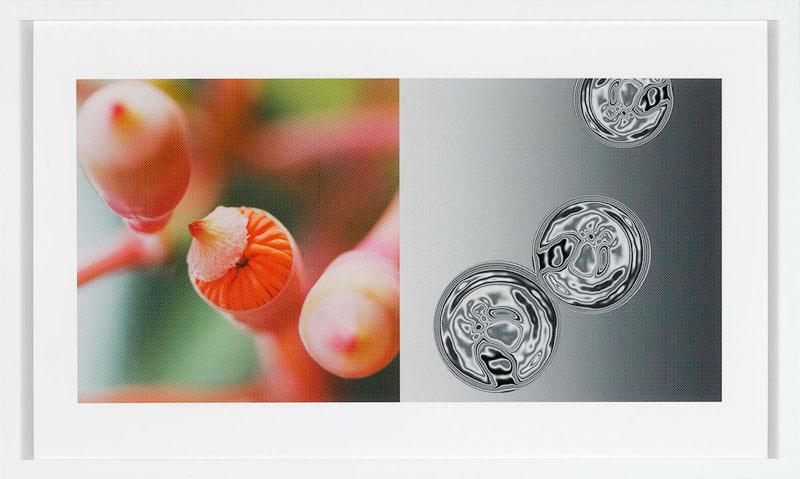
Geoff Parr (b. 1933- d. 2017) was a photomedia artist who was born in Sydney but lived and works Hobart, Tasmania where he was Professor Emeritus of Art and an Honorary Research Associate at the Tasmanian School of Art, University of Tasmania.
In this series of digital prints, Parr stretches the possibilities of surface tension created by neo-pointillist rendering techniques. Inspired by the patterns and forms of natural materials found in the Tasmanian bush, Parr’s recent work has incorporated imagery sourced from the state’s widely publicised old growth forests. In this series, parallels are drawn between unfurling saplings and maturing gum-blossoms and the ways in which water droplets react as seen under magnification revealing the interconnectedness of nature.
Artworks by Parr are held in the public collections of the NGA, MCA, Art Gallery of SA, NGA, Tasmanian Museum and Art Gallery, University of Tasmania’s Fine Art Collection, QAGOMA, Queen Victoria Museum among others.

RaymondARNOLD
Imaginary LandscapeEighteen Months in Tasmania, 1985

Etching on seven sheets of paper #5762
When one of Australia’s leading printmakers, Raymond Arnold (b. 1950, Melbourne), left Melbourne for Hobart in the early 1980s, he made his home in terrain that would preoccupy him for many years. Arnold’s passionate concern for the environment and its protection has been borne out in prints that bring together geology, landscape and an examination of nature/culture binaries.
This work already entitled an “imaginary landscape” highlights that Arnold’s images are not merely representational. The durational aspect of the title is also suggested by the vertical cuts in the print that suggest that each plate/section was sketched at a different time over the 18months. The sublime nature of the placeless cliffs harks back to the picaresque tradition of European Romanticism, although in this case displaced to Tasmania.

NancyNOONJU
Ngarbel Ngarbel, 1999
Painting Natural earth pigments on canvas #10285
Nancy Noonju was born c1940 in the Billiluna community south of Halls Creek on the northern edge of the Great Sandy Desert in North Western Australia. She is a Walmajarri speaker, and her skin name is Nimitj. With most of her childhood and working life spent on Cherubun Station in the West Kimberley, as a young woman Noonju worked as a cook on cattle stations. Today she lives at Emu Creek, 10kms from Kununurra. Kununurra is the home of Red Rock Art, the artists’ collective with which she is associated.
Noonju’s individualistic hand ground ochre paintings depict the Emu Creek region, especially the wet season with its monsoonal rains and cyclonic winds. In this work, Noonju remembers the biggest waterhole on Cherubun Station and refers to it as Ngapa, which in Walmajarri means water. The artist’s particular Dreaming is water and wind – Ngarbel Ngarbel – and as a result this waterhole has great significance for her. Winds are often represented by linear structures corresponding to the rippling surface of the water on the many lakes and waterways of the area.

NellieGORDON
Waterways on Sturt Creek Station
, 1999

Painting
Natural earth pigments on canvas #10288
Nellie Gordon was born in Billiluna in Western Australia in the 1930’s. As a young girl she worked as a domestic in homesteads at Gordon Downs Station and then Nicolson Station in the East Kimberly region. When the equal rights bill was passed in the late 60’s most Aboriginal Station workers lost there jobs and were forced to move into the major centres. She currently lives at Emu Creek, east of Kununurra, Western Australia. She speaks Walmajarri. Gordon began painting in 1996 with the Waringarri Aboriginal Arts Cooperative. As an apprentice and wife to the late George Wallaby, Gordon has developed as an independent and highly skilled artist. She paints Dreamtime stories associated with her country near Billiluna, south of Halls Creek on the northern edge of the Great Sandy Desert. Sturt Creek - referred to in Nellie's painting - flows into the Great Sandy Desert ending at Lake Gregory. It consists of a myriad of channels depicted in this work.

RubyPACKSADDLE

Kooloo Kooloo Hills, 1999

Painting Natural earth pigments on canvas #10289
Now a member of the Emu Creek community east of Kununurra in Western Australia, Ruby Packsaddle was born around 1935, in the Victoria River Basin. She has spent much of her life on stations in the western region of the Northern Territory. Her cultural totems are the snake, which in the Dreamtime shaped the country. Packsaddle is one of the few people who still speaks Jaminjoong, the language of a small tribal group that lives between Timber Creek and Daly River and the Bradshaw Stations. She has developed a distinct style of painting in her use of a basic palette of ochres and her works are often characterised by a striking simplicity. Packsaddle paints only two hills - the Kooloo Kooloo Hills – that lie in the area she grew up in. The Kooloo Kooloo were formed by the Whip Snake (Gaarning), which stopped there on its mythological journey through Packsaddle’s country. Always using a simple palette usually of just two or three colours, Packsaddle dots the entire background of the painting in various designs, leaving the hills as large flat areas of ochre. Packsaddle’s unique and characteristic style signals the innovative and contemporary developments in the art of the East Kimberley region and as a result, her works have immediately and consistently met with interest from collectors throughout Australia and she is represented in collections including Parliament House, Canberra and Wesfarmers, Perth.
ScottWHITAKER
Samsonvale Series, 2000 Painting Oil on canvas #10536 - #10545 (10 part)
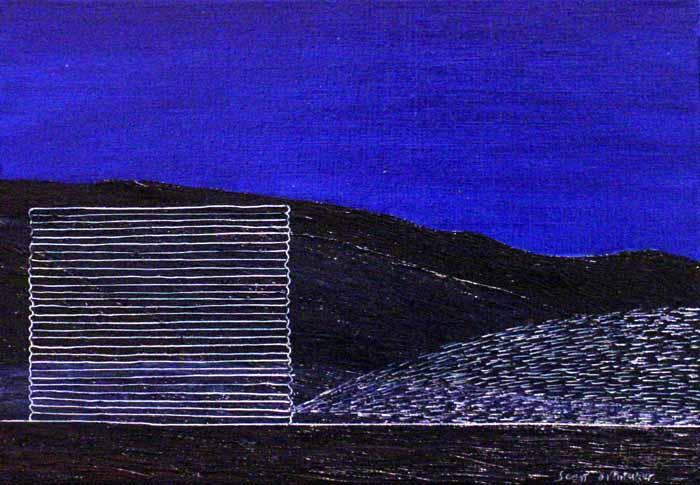

Scott Whitaker (b. 1969) is a Brisbane based painter and ceramicist. Whitaker has become known for his stylised responses to patterns of light and weather, and everyday objects found in the rural landscape surrounding Brisbane.
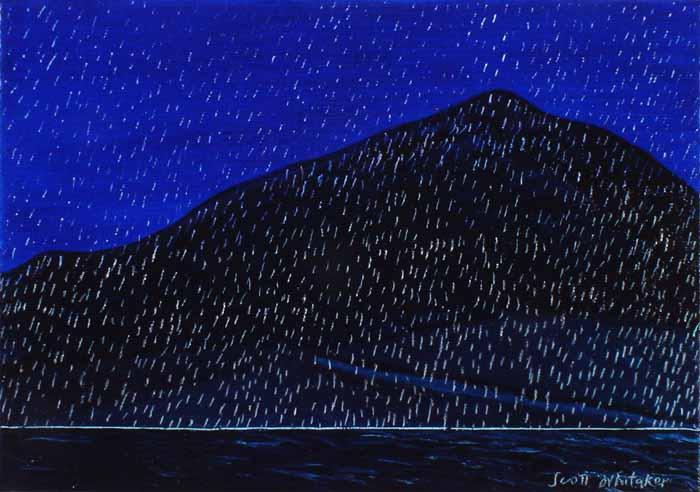

This series is characteristic of his approach to representing the luscious rolling hills and cultivated land with bold colours, and the striking flattening of the space with the abstracted patterns of chicken wire, tanks and rain etched into the surface of his luscious oil paint.



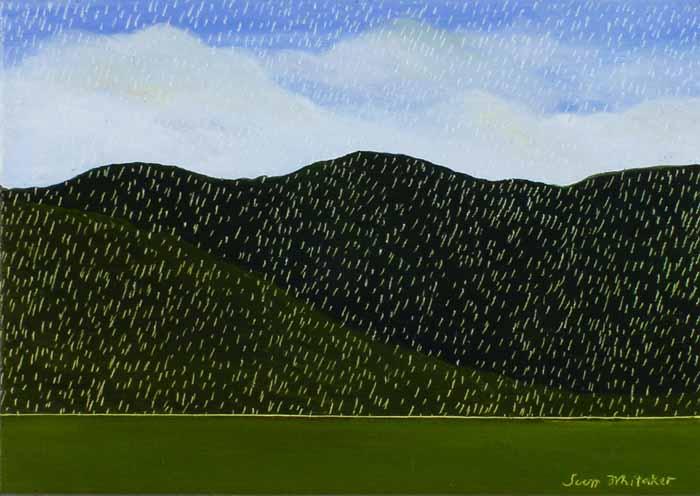



PeterADSETT
Peter Adsett (b. 1959, Gisborne, New Zealand) has lived and worked in Australia since 1981, developing his abstract painting practice. Often using black and white, in endless variation, his work is not graphic but painterly. Adsett’s art is a critique of abstract painting from the early 20th century to today, a task he says became further complicated when he confronted the art of Indigenous Australians.
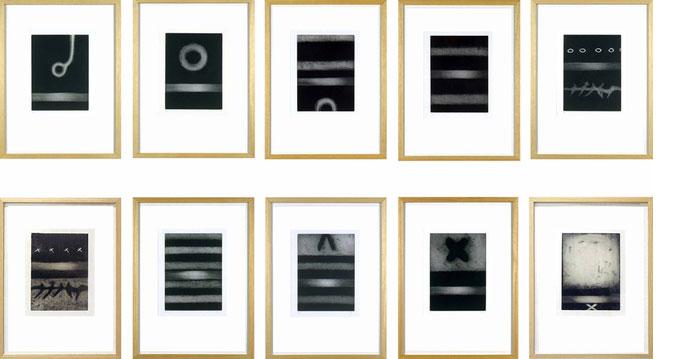
In 2000 he completed a series of large-scale acrylic paintings in collaboration with the Gija artist, Rusty Peters. The resulting exhibition of 14 works (seven each) titled "Two Laws, One Big Spirit" travelled around Australia and New Zealand. The artists called it a ‘conversation’ using a vocabulary of visual abstraction. At this time Adsett was living in Humpty Doo, south east of Darwin (since 2009 he lives in Victoria). This series of work is an abstraction not only of representational aspects of the station but also conjures the spirit of the place.
In 2001 he was awarded a grant from the Pollock-Krasner Foundation and enjoyed residencies in the International Studio and Curatorial Program in New York, and The McDowell Colony in New Hampshire. Adsett’s work is held in institutions and museums in Australia, New Zealand, and Japan.

MichaelaGLEAVE
Michaela Gleave (b. 1980) has a conceptual practice that spans numerous mediums and platforms including digital and online works, installation, performance, photography, sculpture, and video. Her projects question the nature of reality and our innate relationship to time, matter, and space, focussing particularly on the changing intersections between art, science, and society. Gleave’s work has been presented extensively across Australia as well as in Germany, Greece, The United Kingdom, Austria, Hong Kong, South Korea, Japan, Iceland, the United States and Mexico.
In Michaela Gleave's photo-series 'I would bring you the stars' the viewer is presented with a sequence of images in which fireworks explode from a red wheelbarrow seen at dusk. The context and location of the event is left unexplained which adds to the poetic resolve of the work. The ambiguity of the action is a play on the words of the title, a romantic literalisation of the metaphor of giving someone a star, an exploding ball of gas and plasma brought down to earth as an offering of devotion.
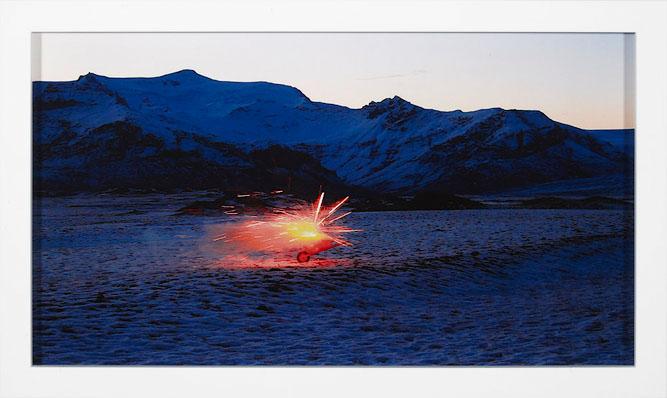


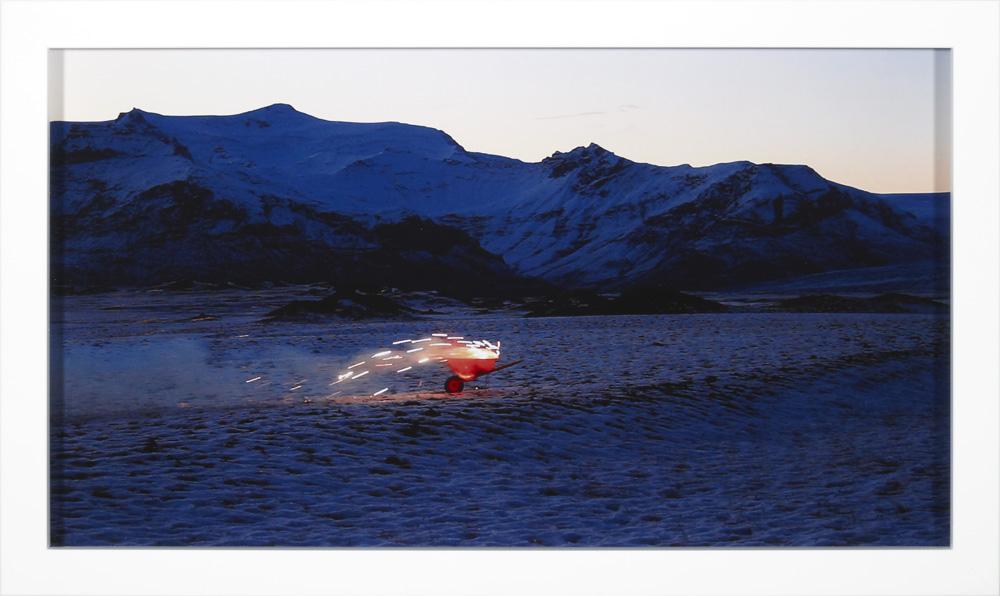
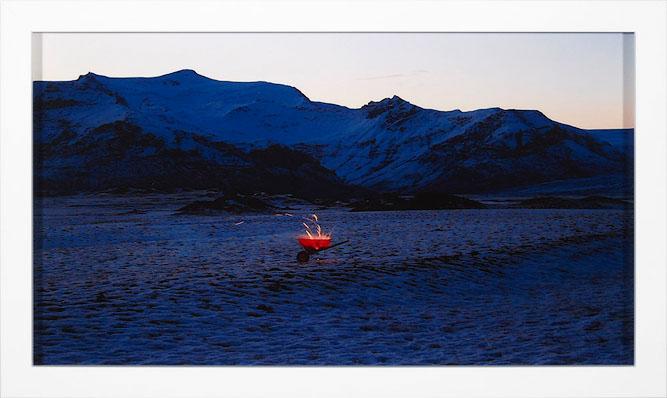
Gleave’s projects and exhibitions include the TarraWarra Biennial 2021: Slow Moving Waters, and Messages of Hope, Art Gallery of NSW, Sydney, 2020.

PenelopeDAVIS
Penelope Davis (b. 1963, Melbourne) is known as a “post-photographic” artist. She uses various photographic techniques, often found in the early history of photography, to produce images without a camera.
These images by photographic artist Penelope Davis are photograms, created by placing objects directly onto photographic paper before exposing it to light. The objects Davis used in the ‘Zip’ series are resin casts of camera lenses. The cameras themselves are used through complex casting practices. Both the photogram and the cast indexically reference their subject, they are not “representations” but ghosts of the real thing, made without the hand of the artist.




Light passed through a lens to create these images, but not in the expected way; no camera was used in creating these ‘photographs’. The resulting images look uncannily like eyes, with the coloured rings of irises and dense black pupils. Davis plays cleverly with the act of seeing, recording and producing images, inverting the role of the camera from tool to subject.

LizRÁCZ
Opposite a tractor, 2003 Sharkplane plus chaser, 2003
Painting Oil on canvas #11186 & #11187

Liz Rácz (b. 1969, Melbourne) is a multi-disciplinary artist and has lived and worked min France . She employs painting, drawing, printmaking and installation in her practice. Her latest work focuses on animation and various constructed praxinoscopes, both in two and three-dimensions. She is also experimenting with graphite drawings which function as circuits. Racz has an ongoing interest in how drawing and sculpture meet other technologies.
In ‘Sharkplane plus chaser’ and Opposite a Tractor, the artist has deployed figurative and abstract genres to playful ends propelled by a luminous palette. The painting has a quirky naïve style that belies the more serious functionality of its subject matter.

Rácz’s art studies include a Diploma of Visual Arts (Public Art) RMIT University, 2004 and a Tihany International Postgraduate Program, Hungary, Hungarian Academy of Fine Arts and Goldsmith’s College London, Tihany, Hungary, 2006.

SimonCUTHBERT
Simon Cuthbert (b.1964) is a multi-disciplinary artist, curator and photographer whose practice often reflects the history of early Tasmania and a passion for the environment. Cuthbert photographs modernist architectural views and places within a city. He decides on images for their poetic potential and often the subject suggests forgotten histories or unrealised utopian dreams. Under Cuthbert's objective lens, what he calls “bureaucratic vision”, these places take on a beautiful and haunting feel.
In this work, a tower is in mid build, the building is split into a picaresque three parts (almost like a traditional landscape). The base is already complete, the next third is under hordings and the final third is yet to be complete and appears as a concrete skeleton. It is an image that shows the nitty gritty of utopian visions, all perfect and mirrored glass.

As critic Jane Rankin Reid states: "Cuthbert provokes [a] level of mediation between the artist and the built and natural worlds ... there are a series of unnatural expectations ... proposing another worldly vision of 21st century human endeavour and expression."

JamieBOYS
If you can't see my mirrors, I can't see you, 2007 One monkey don't stop the Show, What about.., 2007
Painting
Synthetic polymer paint and ink on canvas #12214 & #12215
Jamie Boys (born 1972) is known for his kooky, humorous and highly stylized imagery which hovers on the edge of graphic design and reflects his interest in animated illustration. His visuals puns invite the viewer to take a second (or third, or fourth) look at his work to extract the underlying relevance and meaning of the comical settings.



If you can’t see my mirrors, I can’t see you, takes the classic warning of truckies and recontextualises it to relationships. Is Boys suggesting that in relationships too people have to move out from psychological blindspots. One monkey don't stop the show. What about ..., is potentially more obscure. The work may refer to the slang phrase, “having a monkey on your back,” as an anxiety or worry that follows you around. The man presents himself to a viewer/suitor with his worries opn clear show.
Boys studied at the Emily Carr Institute of Art and Design in Vancouver, Canada – the result of a Kerley Travelling Scholarship awarded to him by the VCA.
AnnTHOMSON

Spinner, 1980 Wind Buggy, 1980 Turning, 1980 Drawing Collage on paper #501
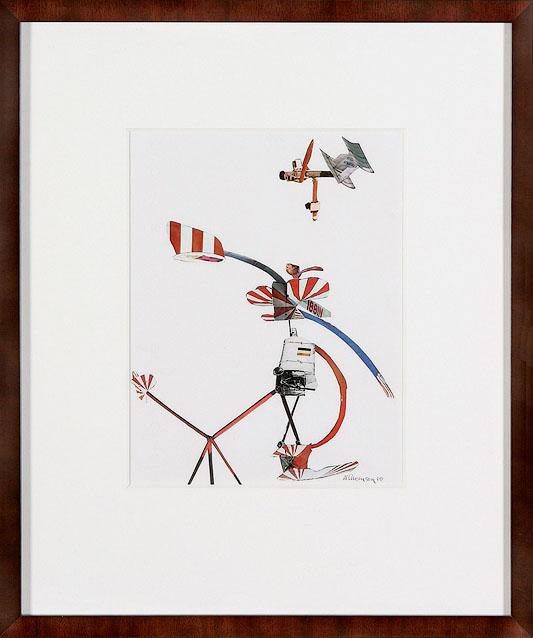


Ann Thomson (b. 1933, Brisbane) works in painting, sculpture and printmaking. Her work is exploratory and widely varied. Drawing from traditions of expressionism, abstraction and modernism. Art making comes from her subconscious, as ideas and images gathered throughout her life.
These small and fun collages seem particularly to come from a surrealist almost stream of consciousness approach. Collage allows for misconnections and changes of scale. Turning, Windbuggy and Spinner, all seem to be a variation on the theme of irrational wind driven vessels. The works recall ultralight planes and boats but also the magical machines of Leonardo da Vinci or even Daedalus. They represent that deep psychological urge to escape, to lift off and fly away.
Thomson has won a number of prizes, including the Wynne Prize, Kedumba Drawing Prize, 2002 Geelong Contemporary Art Prize and major commissions include Australia Felix, the central sculptural installation at the 1992 World Expo in Seville. Ann Thomson's work is included in many important collections such as Art Gallery of New South Wales, Newcastle Regional Art Gallery, Thyssen-Bornemisza Collection, Madrid and Villa Haiss Museum, Germany.
PeterNELSON
Campfire Setting, 2008 Clearing after Spring, 2008
Painting Oil on canvas #12516
Peter Nelson (b. 1984) is a Hong Kong based painter who takes a multi-disciplinary approach to painting and drawing, fusing aspects of technology and traditional techniques. Nelson is also very interested in the varied approaches to landscape both in the Eastern and Western traditions. His research area currently is the interaction between landscape art history and the aesthetics of computer games.

These works show an interest in the techniques of traditional Chinese landscape painting which are morphed into surreal floating landscapes. Painted with a flattened perspective and in cool blue hues, 'Campfire Setting' and 'Clearing (after Spring)' appear to hover between real and imagined spaces. Although littered with the remnants of human presence – building remains and debris – the works are apocalyptic. Void of the figure the works suggest an eerie emptiness, suggestive of a world of portent or loss.
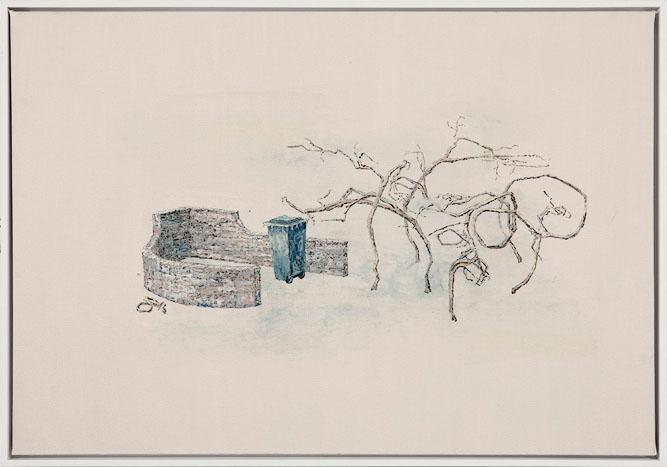

MeaganPELHAM

Dream Owl, 2013 Owl Fashion Models, 2013 Print Etching and aquatint #14459 - #14460
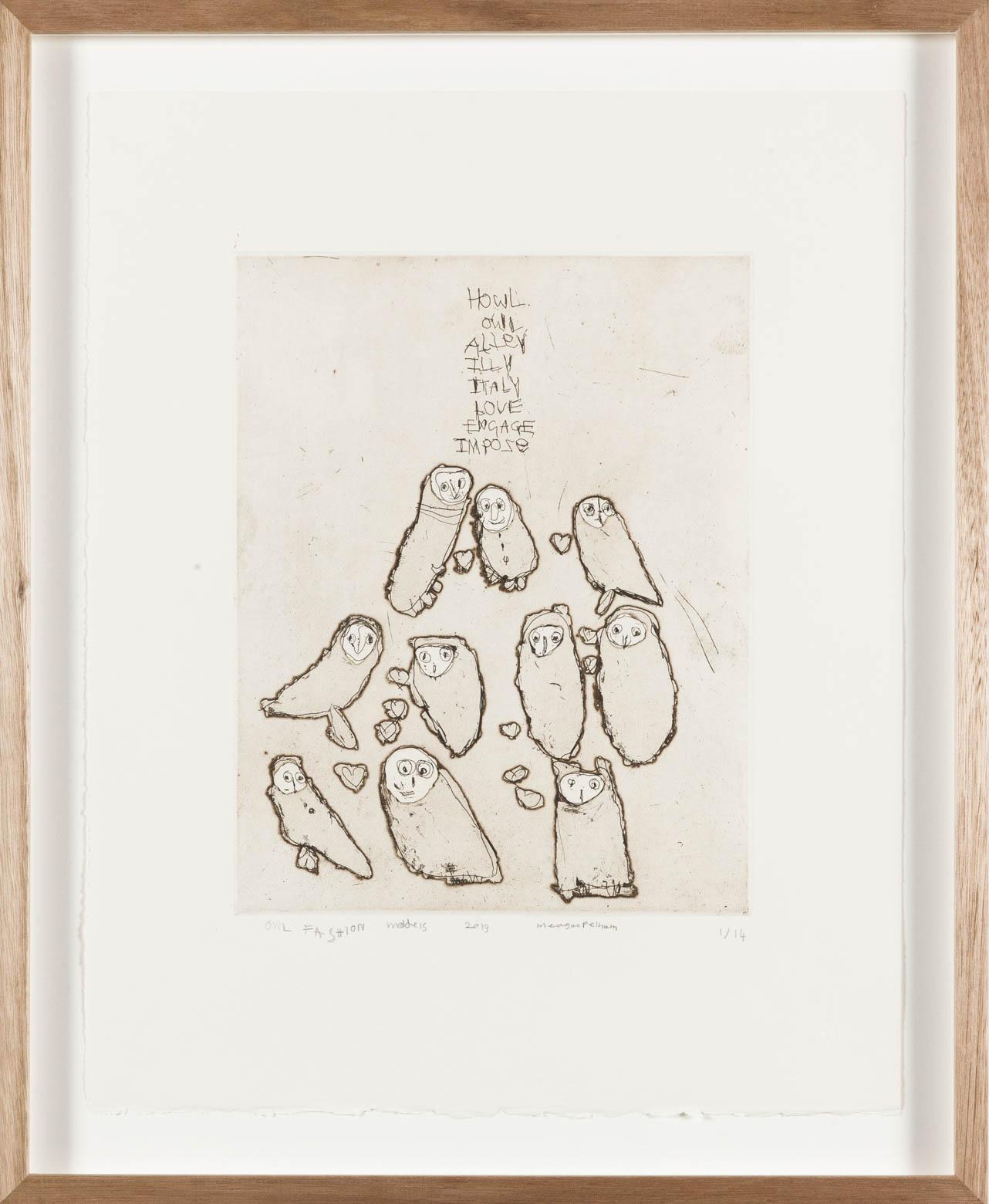
Meagan Pelham (b. 1989) is a multidisciplinary artist practising in painting, poetry, drawing and performance. Meagan uses delicate line work to depict emblems of devotion and delight, including wedding cakes, red roses and love-heart-shaped cocktail glasses. Her favourite subjects are her signature ‘love owls’, which she often draws in pairs to signify how they are the most romantic of animals.
These two prints featuring a 'Dream Owl' and 'Owl Fashion Models', show a lyrical sense of line and a poetic fusion of image and text. Pelham completed these works while a guest artist at UNSW Art & Design's Cicada Press.
Pelham operates out of Studio A in North Sydney . Pelham was a finalist in the Archibald with a portrait of Anna Plunkett from Romance is Born.

AlMUNRO
Infinite Object I & II, 2014 Painting

Synthetic polymer paint and pigment marker on canvas, #14060 & #14061
Al Munro (b. 1964) is a Canberra-region artist whose practice spans textile, painting and drawing-based media. Her recent work in takes as its point of departure the relationship between textile structures and mathematics, investigating the geometry of pleating and various pattern systems.
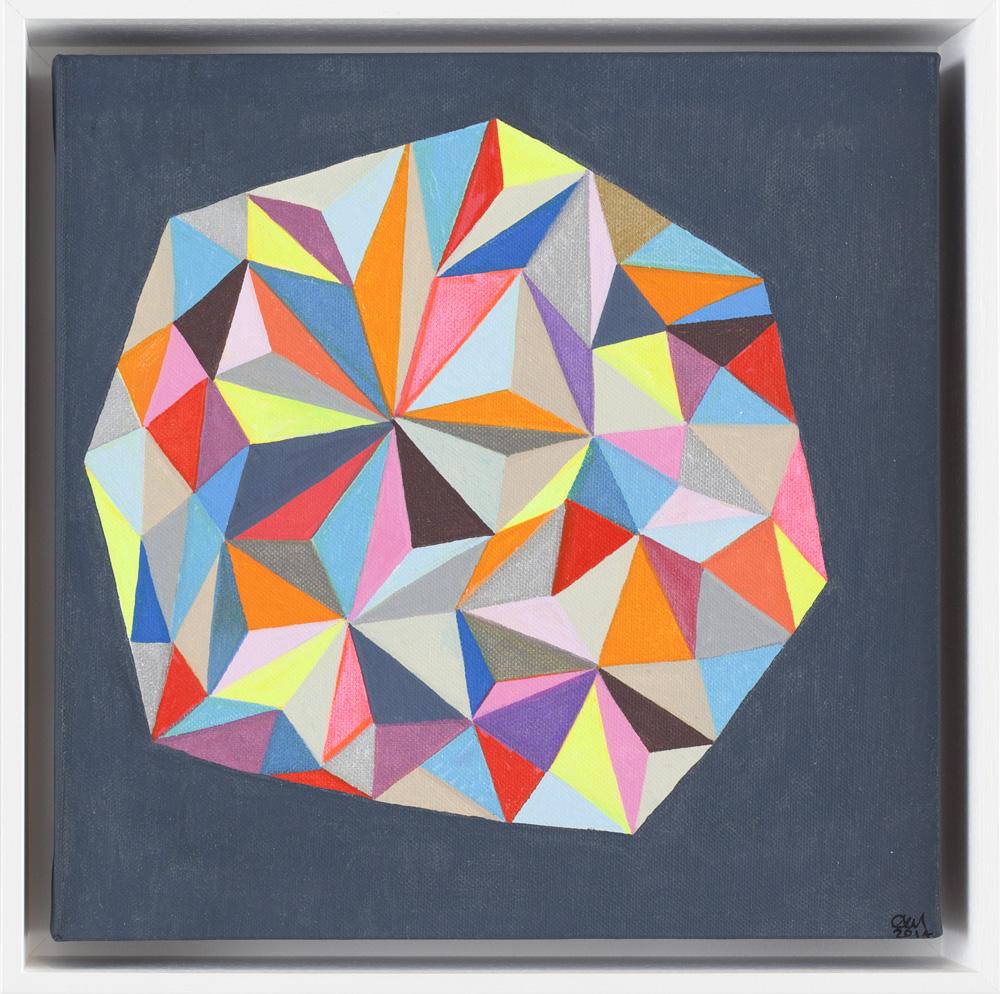
The science of crystallography is the study of the structure and properties of crystals. Canberra based artist Al Munro uses this discipline as the starting point for an ongoing series of works that evoke crystal formations and the codified structure of these forms. 'Infinite Object I and II' take as their starting point the repetitions and refractions evident in crystallographic diagrams "which function as descriptions of the natural world in terms of mathematical code", explains Munro, "but which, like any code or language, can be spoken and written in unintended ways." The result is a bold abstract composition of light, colour and form that offers an insight into the unseen structures of the natural world.

KylieBANYARD
Soleri's Studio, 2014 Painting Oil on canvas #14040

Kylie Banyard (b. 1974) is a multidisciplinary artist and educator. Her artistic practice is grounded in painting and intersects with photography, video, sculpture and immersive architectural spaces. Banyard has for sometime explored the notion of utopia, and utopian communities including Black Mountain Art College and Soleri’s Studio. Her work often depicts obsolete technology and exterior views of unusually idyllic and alternate dwellings. In recent work there has been a turn to the biographical and how Banyard has applied ecological and social principles to her own life and parenting.
In 'Soleri's Studio', Banyard chooses to investigate the interiorand her subject is the pottery studio of Paolo Soleri, the founder of an experimental community in the Central Arizonian desert. Soleri is known for his vision to harmonise architecture and environmentalism and his work speaks fluidly to Banyard's ideal of a balance between community, home and progress.
Banyard was included in The National 2019: New Australian Art at the Museum of Contemporary Art Australia and recently completed a VR Studio with Tactical Spacelab (funded by the Australia Council and Arts NSW).

CarolineROTHWELL
Sign I, II, III, IV, 2007


Painting Vinyl on aluminium #11983 - #11986


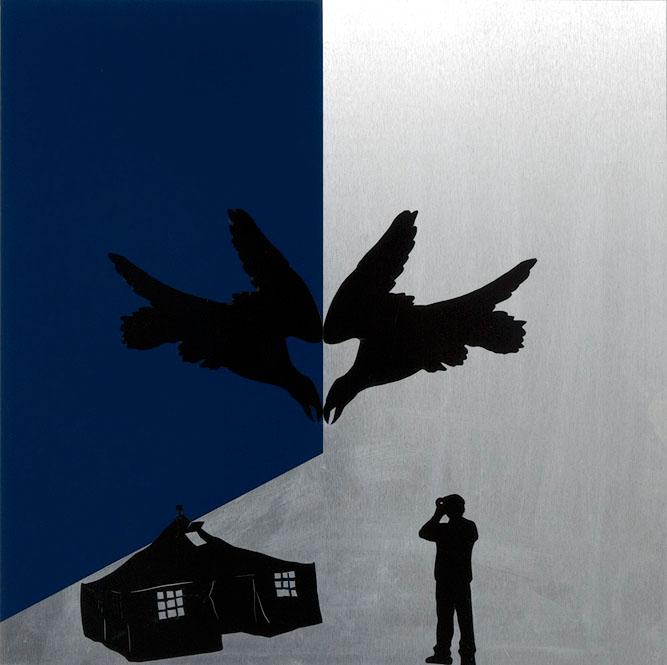
Caroline Rothwell (b. 1967, Hull, England) explores the evolving relationships between humans and the natural environment, in drawings, sculptures and installations. She has become well-known for her silver-plated sculptures of animals and plants, cast from hand-sewn fabric moulds, that morph into hybrid forms.
In the 'Sign' series, Rothwell has hand cut the kind of PVC used by commercial signwriters. The silhouetted human figures look through binoculars - a reference to nature, or perhaps the increased surveillance in our cities. The images are set on aluminium used for road signs. Rothwell subverts our expectations of the mass produced by insisting on the presence of the hand-made, of human intervention. She takes the material of the law and the bureaucracy, and makes it again fictional, narrative and strange.
Rothwell has been commissioned to create sculptures for the Goodwood Sculpture Park in England; for Ferrier Hodgson at Grosvenor Place, Sydney; and has completed major projects in New Zealand for Christchurch Botanical Gardens.
Ada BirdPETYARRE

Ada Bird Petyarre (b.1930– d.2009), painter and printmaker, was an Anmatyerre woman from the Northern Territory, and one of seven sisters who all became notable artists. She was born on the pastoral lease Utopia, located in the Sandover region north-east of Alice Springs, and did domestic work on the station as a young woman. As was so for her kinswoman, Emily Kame Kngwarreye, Petyarre’s art practice commenced in the late 1970s when the Utopia women were introduced to batik and other dying and textile painting techniques. She was one of the founding members of the Utopia Batik Group.
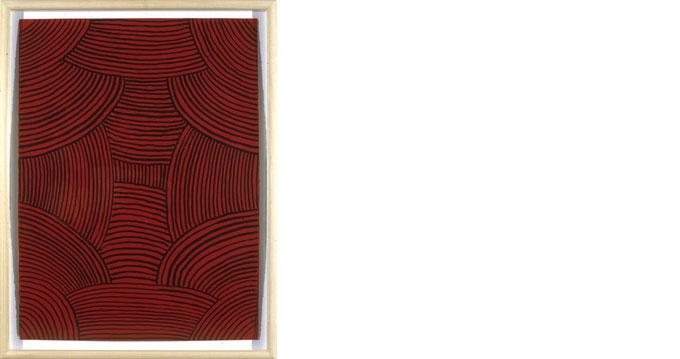
Petyarre depicts the awelye (body paint) for arnkerrthe, the Mountain Devil Lizard. The mass of curved lines is directly taken from the lines of ochre painted on the breasts, shoulders and upper torso of the body.
Petyarre’s paintings are held in the collections of the National Gallery of Australia; the Art Gallery of South Australia; the Art Gallery of New South Wales, and the Kelton Foundation, Santa Monica, USA, along with the corporate collections of Robert Holmes à Court and Allen, Allen & Hemsley. In 2000-2001 Petyarre was the recipient of the prestigious Australia Council Artist Fellowship.
Gloria Tamerre PETYARRE

Arnkerrthe (Mountain Devil Lizard), 1997
Gloria Tamerre Petyarre (b. 1945) is a senior Utopia painter. Petyarre's distinctive and abstract approach to painting draws on the designs of women's body decorations and the main dreamings of the Mountain Devil, Bush Medicine, Bean, Emu, Yam and Grass Seed.

The story of Mountain Devil, Lizard Dreaming refers to the Petyarre sisters’ shared totem of the thorny devil lizard. The crossed diagonal lines symbolise the ancestral trek of the lizard in the Altyerr that formed features of landscape and country just beyond Aniltye in Utopia, located in a sacred sandhill that traverses the homelands. The lines of cobweb tracery mark the Women’s Awely ceremony for the spiritual sustenance of this particular clan Dreaming.
Information that accompanied the work from Flinders Lane Gallery describes: 'This painting tells the story of a very small lizard-like creature that has the ability to change colour according to the landscape. Not only does the colour change, but the actual pattern on the skin changes. The lizard also camouflages itself by carrying ochre particles on its back. This sacred lizard carries a Dreamtime story that is passed on from generation to generation and the swag like-lump on its back represents the Dreamtime.'
Deborah WURRKIDJ
Black Plum, 2006 Pandanus Weaving, 2006


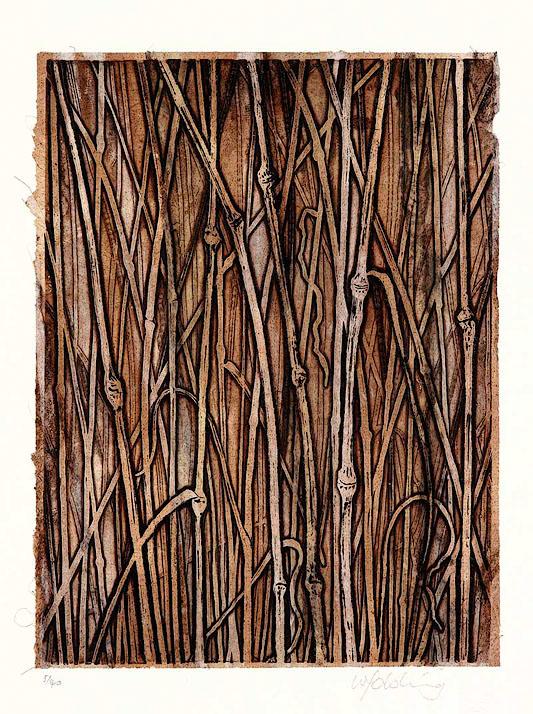

Judy WATSON
Bat-wing coral tree, red bean tree, 2006 Sand palm, dodder laurel, flat-leaf plant, 2006

Fiona HALL
Shrubby Dillenia Leaf and Wasp Nest, 2006 Green Ant Nest, 2006


Winsome JOBLING
Spear Grass, 2006 Fertile, 2006

Marita SAMBONO
Water-lilies, 2006 Fog Dreaming, 2006
Irene MUNGATOPI
Green Plum Leaf, 2006 Pink Beach Apple, 2006

This series of prints were created and exhibited in 2006, entitled Replant: A New Generation Of Botanical Art. The series celebrates the traditional role of women as gatherers of food and holders of knowledge and involved six indigenous artists: Debra Wurrkidj, Fiona Hall, Irene Mungatopi, Judy Watson, Marita Sambono and Winsome Jobling. Working collaboratively the works begun with an excursion for all artists to the Daly River, 230 kilometres southwest of Darwin. Glenn Wightman and traditional knowledge custodians Biddy Lindsay, Patricia Marrfurra and Marita Sambono shared their knowledge and observations on cultural stories, plant use and scientific knowledge.



Each work then is a carefully studied look at the particular characteristics of top end plants, that survive and prosper through the climatic extremes of monsoonal rains, dry weather and wild fires. The group then returned to Darwin to the printmaking studio of master printmaker Basil Hall to resolve the work. Some artists impressed actual plants onto their zinc plate as a starting point, others painted and drew directly. The variety of approaches is an exciting aspect of the series.
Replant was exhibited at George Brown Darwin Botanical Gardens August 2006 as part of the Darwin Festival.
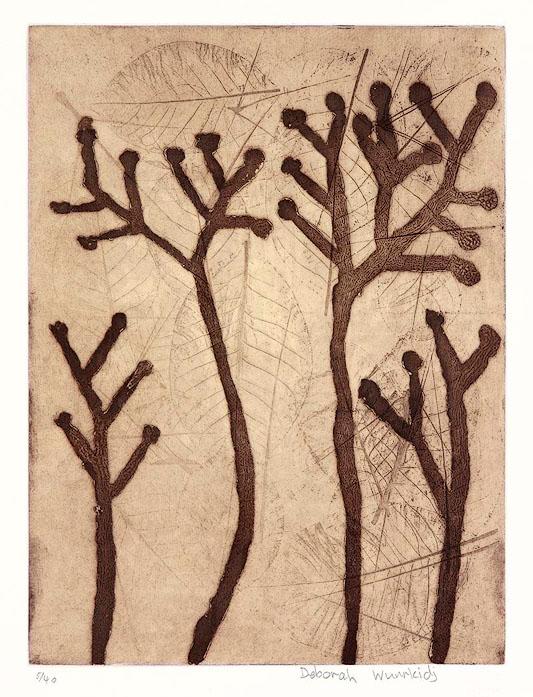
VictorMOTLOP
Victor Motlop (b.1961) is from the Wagadagem tribe of Mabuiag Island in the Torres Strait. He grew up in Bamaga, a tiny town at the very tip of Cape York Peninsula, Queensland. After leaving school he stayed in Bamaga to develop his artistic skillsspecialising in painting, woodcutting and weaving - while working as a cray fisherman, trocus diver and carpenter.
In 2000, the Elders of Mua Island agreed to establish a print studio in Kubin Village, the Mualgau Minaral Artist Collective, so that four young printmakers, Dennis Nona, Billy Missi, David Bosun and Victor Motlop, could record the Island’s’ special creation stories. These artists utilised their traditional carving skills to create an art movement based on the fine incising of traditional patterning into linoleum and printing on to archival paper.
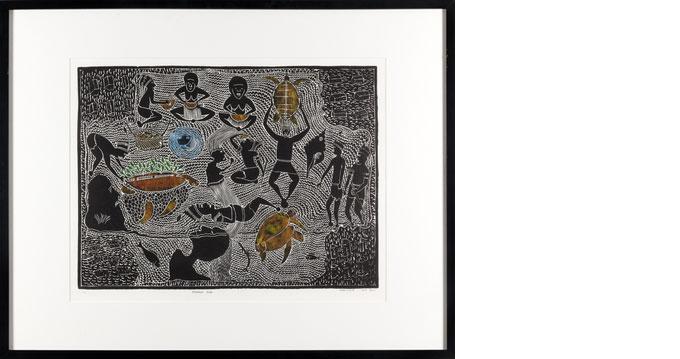
This work is a story depicting the spirits that became the geographical markers of Mua Island. A man, Zangagudan and his wives came upon a giant sleeping Karakarkula. Tricking the giant to catch a turtle for them, the giant soon fell asleep. When he awoke the turtle had already been eaten. Angry he chased the people and turned to stone himself, creating Mua Island.

DavidBOSUN

Lagau Mabaigau Malu
David Bosun is from the Wug tribe of Moa Island, in the Torres Strait and his language group is Kala Lagaw Ya (Near Western Torres Strait Islands). Born in 1973, he practiced traditional singing and dancing as a young child and, after studying communications, he became an artist in 1997.
This linocut traces the creation stories and iconographic symbols of the Daur, Waier and Mer islands. This print depicts the main seafood Torres Strait Islanders gather on their hunting trips, . The hammerhead shark is the Islander's competitor and is feared more than any other shark because of its attacking technique.
The context of the image is the Islander respect for the ecosystem and the need to fish sustainably. According to the artist, 'today rubbish is dumped in the sea and many species are over hunted. The little respect shown to the environment will lead to the destruction of the reef and feeding ground of the animals which are the food resource that the Torres Strait Islanders rely on.”
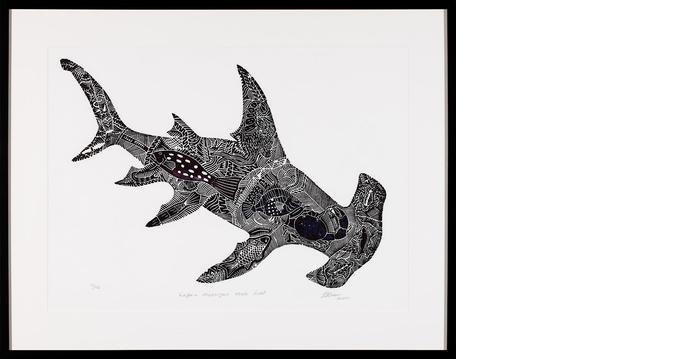
DennisNONA
Yellub A Ngau Unai, 2003
Dennis Nona (b. 1973, Badu Island) is widely considered to have pioneered the highly intricate linocut prints that are unique to the Torres Strait. Along with other artists from the Mualgau Minaral Artist Collective from Mua Island in the Torres Strait, he utilises traditional carving skills to record the Islands’ special creation stories and developed an art movement based on the fine incising of traditional patterning. The traditional stories had been previously recorded and transmitted by dance and oral story telling.

Nona uses a graphic way of story telling by producing a single image that relates to an entire narrative. The events and characters are combined with intricate clan patterning to bind the story to its place of origin. Within Nona’s work there is a celebration of island myths and legends, of how humans, animals, plants and landscape took their meaning from epic or magical events in the past. This work talks of Yellub who lived in a place called Palga. It is a story, as told by Father John Manas, about treating dogs with respect as they help so much with hunting. Leaving his dog behind, on a fishing trip, the dog told villagers that Yellub mistreated him. When Yellub returned they turned against him and Yellub never fed his dog “dried bones” again.

Paddy Carroll TJUNGURRAYI
Hare-Wallaby Dreaming, 1984 Painting Synthetic polymer paint on canvas #3452
Paddy Carroll Tjungurrayi (1927-2002) was one of the key painters in the Papaunya Tula art movement in the late 1970s. An artist with Anmatyerre and Walipri tribal affiliations, Tjungarrayi’s approach to painting is derived from ground paintings and body decoration. The striking compositions for which he has become most well known depict a range of significant Dreaming stories and sites of ceremonial relevance.
The design elements in this painting are associated with the Mala or Hare-Wallaby Dreaming at the site of Umatji, near Chilla Well. The Mala people travelled to thius site from Ilpili to the west of Papunya. The oblong shape in the centre of the painting represents a ceremonial pole decorated ready for the ceremony. The circles on either side depict the homes of the Mala and the adjacent arcs are their whiskers.
Paddy Carroll Tjungurrayi (1927-2002) was one of the key painters in the Papaunya Tula art movement in the late 1970s. An artist with Anmatyerre and Walipri tribal affiliations, Tjungarrayi’s approach to painting is derived from ground paintings and body decoration. The striking compositions for which he has become most well known depict a range of significant Dreaming stories and sites of ceremonial relevance.

The design elements in this painting are associated with the Mala or Hare-Wallaby Dreaming at the site of Umatji, near Chilla Well. The Mala people travelled to thius site from Ilpili to the west of Papunya. The oblong shape in the centre of the painting represents a ceremonial pole decorated ready for the ceremony. The circles on either side depict the homes of the Mala and the adjacent arcs are their whiskers.

JudyWATSON

Waanyi clan descendent Judy Watson *b. 1959) creates poetic and political works with strong matrilineal ties to kinship and country. The impetus for much of her printmaking and painting stems from the experience of returning to her grandmother's country in north western Queensland in 1990. This encounter had a profound effect on her artistic practice and subsequent works are often autobiographical as well as canvasing the politics of contemporary Aboriginality. Watson says of her family experience: "I listen and hear those words a hundred years away. That is my Grandmother’s Mother’s Country. it seeps down through blood and memory and soaks into the ground". This triptych is from the Land Portfolio in 1992.

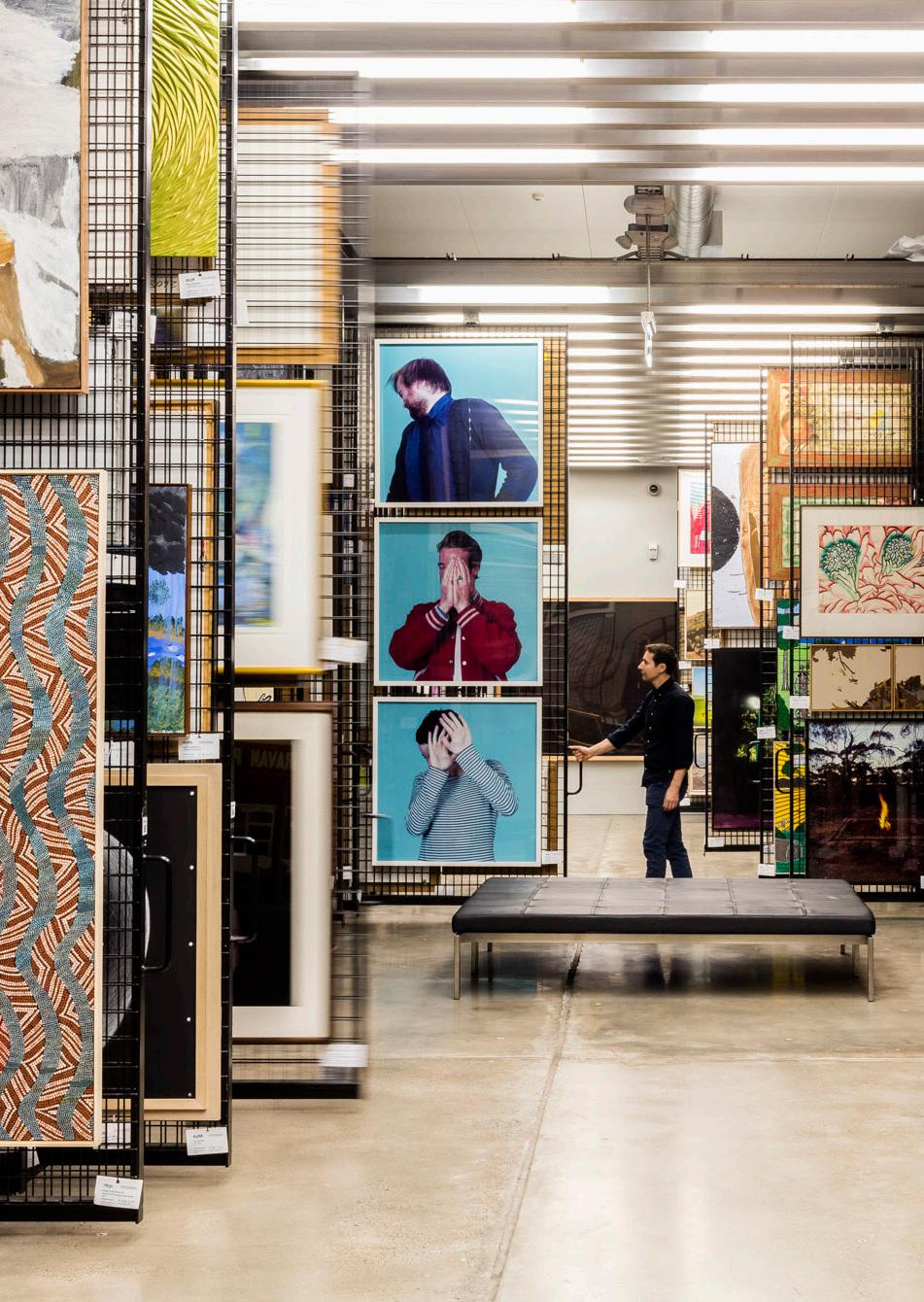
Caring for your collection
In welcoming Artbank works into your space, follow these tips on looking after them for us;
• Advise any cleaning staff to take great care when cleaning areas around artworks.
• Contact your consultant if a work needs maintenance like dusting or cleaning.
• Please ensure the artworks remain untouched and left where they were installed.

• If you need the artworks moved – just call us! We will arrange this straight away for you.
• If you notice damage to any work let us know straight away so we can save the artwork.
Get in touch with an Artbank Consultant today and help support the Australian contemporary artists of tomorrow!
